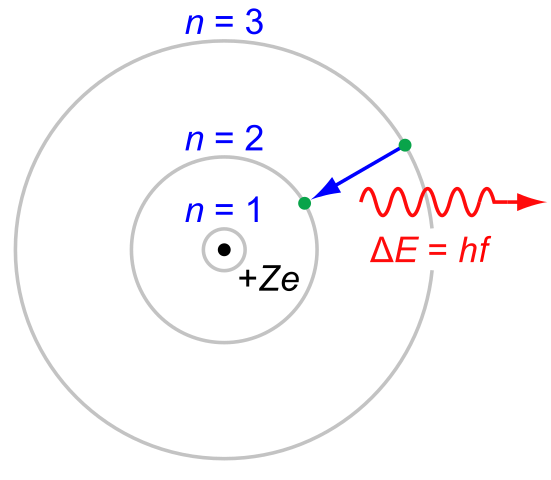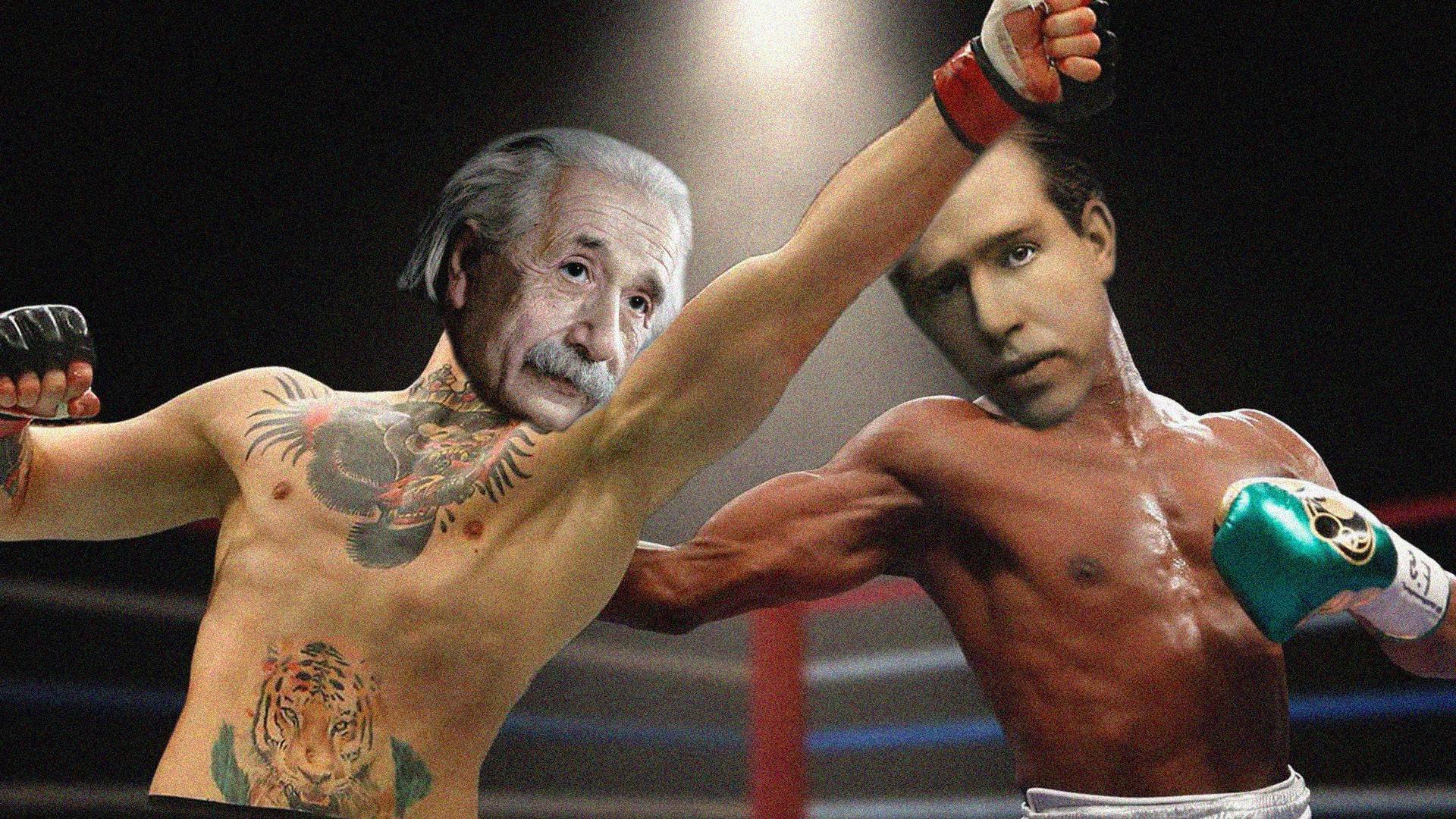
image credits: Wikipedia
Mr. Copenhagen Interpretation
Pan Interpretacja Kopenhaska

I have a pleasure to invite you to the third part of the series dedicated to the participants of the 5th Solvay Conference. This time I will present the life and work of a heavyweight scientist who was one of the leading figures at this famous conference. I'm talking obviously about Niels Bohr, a guy that made quantum mechanics evolved so quickly.

Zapraszam na trzecią już część serii poświęconej uczestnikom 5 Kongresu Solvaya. Tym razem przedstawię życie i dokonania naukowca wagi ciężkiej, który był jedną z wiodących postaci podczas tej słynnej konferencji. Jest to oczywiście Niels Bohr, dzięki któremu mechanika kwantowa rozwinęła się tak szybko.

image credits: Wikipedia
Biography in a nutshell
Biografia w skrócie

Niels Bohr was born on October 7, 1885 in Copenhagen. He had two siblings - older sister Jenny and younger brother Harald. Sister became a teacher and brother a mathematician with a passion for football - what confirms his performance at the 1908 Summer Olympics as a player of Danish national team. Niels also played football but didn't achieve in this discipline as much as his brother. He grew up in an atmosphere conducive to the development of physics interests. His father was a professor of physiology at the University of Copenhagen and his mother came from a wealthy family. His education started at the age of seven. In 1903 he began his studies at the University of Copenhagen. His major was physics, but he studied also astronomy, mathematics and philosophy.
In April 1909 Niels Bohr got a Master's degree and in 1911 he managed to get a Doctor's degree. One year after receiving his PhD, the scientist married Margrethe Nørlund, with whom he had six sons, but two of them died. The oldest - Christian died in a boating accident, and Harald died of childhood meningitis. The remaining four sons have managed to make significant careers in various fields. During his studies, Niels received an award from the Academy of Sciences in Copenhagen for his research (not yet related to quantum mechanics). In 1912 he started working at Ernest Rutherford's lab in Manchester. Inspired by Professor Rutherford, specifically his discovery of the atomic nucleus, Niels Bohr in 1913 published his proposal on how the atom looks and acts. This was a big step in the development of quantum mechanics, because Bohr proposed a quantized model of electron energy levels. Three years after the presentation of the atomic model, Bohr became a professor of theoretical physics at the University of Copenhagen and since 1920 has headed the Institute of Theoretical Physics, which was made for him.
1922 was certainly important to Niels Bohr - he was awarded the Nobel Prize in physics. Later years he devoted his work to the Institute of Theoretical Physics and to the development of quantum mechanics. Bohr was one of the creators of the Copenhagen interpretation of the quantum mechanics.
While the Germans occupied Denmark, the Nobel Prize winner went first to Sweden and then to England and USA where he worked on the peaceful application of nuclear energy. He died on November 18, 1962 in Copenhagen.

Niels Bohr urodził się 7 października 1885 w Kopenhadze. Miał dwoje rodzeństwa - starszą siostrę Jenny oraz młodszego brata Haralda. Siostra została nauczycielką, a brat matematykiem z zamiłowaniem do piłki nożnej - potwierdza to jego występ na Igrzyskach w Londynie w 1908 roku jako reprezentant Danii. Niels również grywał w piłkę nożną, ale nie osiągnął w tej dyscyplinie takich sukcesów jak brat. Dorastał w atmosferze sprzyjającej rozwojowi w kierunku fizyki. Jego ojciec był profesorem fizjologii na Uniwersytecie Kopenhaskim, a matka pochodziła z bogatej rodziny zajmującej się finansami. Edukację zaczął w wieku siedmiu lat. W 1903 roku rozpoczął studia na Uniwersytecie Kopenhaskim. Studiował fizykę, która była jego głównym kierunkiem oraz astronomię, matematykę i filozofię.
W kwietniu 1909 roku Niels Bohr uzyskał stopień magistra, a doktorat obronił w 1911 roku. Rok po otrzymaniu tytułu doktora, naukowiec ożenił się z Margrethe Nørlund, z którą miał szóstkę synów, jednak dwóch z nich zmarło. Najstarszy - Christian zginął w wypadku na morzu, a Harald zmarł na dziecięce zapalenie opon mózgowych. Pozostałym czterem synom udało się zrobić znaczące kariery w różnych dziedzinach nauki. Jeszcze podczas studiów Niels otrzymał nagrodę od Akademii Nauk w Kopenhadze za badania (jeszcze nie związane z mechaniką kwantową). W 1912 roku rozpoczął pracę w laboratorium Ernesta Rutherforda w Manchesterze. Zainspirowany profesorem Rutherfordem, a konkretnie jego odkryciem jądra atomowego, Niels Bohr w 1913 roku opublikował swoją propozycję tego, jak wygląda i działa atom. Był to duży krok w rozwoju mechaniki kwantowej, ponieważ Bohr zaproponował skwantowany model energii elektronów. Trzy lata po przedstawieniu modelu atomu, Bohr został profesorem fizyki teoretycznej na Uniwersytecie Kopenhaskim i od 1920 roku stał na czele utworzonego dla niego Instytutu Fizyki Teoretycznej.
Rok 1922 był dla Nielsa Bohra niewątpliwie ważny - otrzymał wtedy Nagrodę Nobla w dziedzinie fizyki. Dalsze lata poświęcił pracy w Instytucie Fizyki Teoretycznej i rozwojowi mechaniki kwantowej. Bohr był jednym z twórców tzw. interpretacji kopenhaskiej mechaniki kwantowej.
Podczas gdy Niemcy okupowali Danie, noblista udał się najpierw do Szwecji, a później do Anglii i Ameryki, gdzie pracował nad pokojowym zastosowaniem energii atomowej. Zmarł 18 listopada 1962 w Kopenhadze.

image credits: Wikipedia
Bohr model
Model atomu Bohra

Niels Bohr received the Nobel Prize in physics "for his services in the investigation of the structure of atoms and of the radiation emanating from them". It seems to me that it is worth to explain in brief for what he was awarded - the Bohr model. He tried to apply quantum to the construction of an atom because the two-year-old Rutherford model didn't work with classical physics. His research led to some statements:
- electrons can orbit stably around the nucleus without emitting radiation only on specific orbits, called stationary
- electrons can increase and decrease their energy only by jumping from one orbit to another emitting or absorbing a photon with a frequency associated with the energy change between the initial and final orbit
- the angular momentum of the electron is quantized, which means that it can only accept certain values:
L = n ⋅ ħ = n ⋅ h/2π, where n is a positive natural number (principal quantum number) and h is Planck's constant - electrons can exist ONLY on certain orbits, they are never between them

Niels Bohr otrzymał nagrodę Nobla w dziedzinie fizyki „za jego zasługi w badaniach nad strukturą atomu oraz emitowanego przez nie promieniowania”. Wydaje mi się, że warto z tego powodu przedstawić to, za co został wyróżniony - model atomu. Próbował on zaaplikować kwantowość do budowy atomu, ponieważ przedstawiony dwa lata wcześniej model Rutherforda nie mógł działać na gruntach fizyki klasycznej. Jego badania doprowadziły do pewnych stwierdzeń:
- elektrony mogą orbitować stabilnie wokół jądra, bez emitowania promieniowania tylko na określonych orbitach, zwanych stacjonarnymi
- elektrony mogą zwiększać i zmniejszać swoją energię tylko poprzez zmianę powłok, po których krążą, emitując lub absorbując foton o częstotliwości związanej z wartością zmiany energii pomiędzy powłoką początkową a końcową
- moment pędu elektronu jest skwantowany, co oznacza, że może przyjąć tylko określone wartości:
L = n ⋅ ħ = n ⋅ h/2π, gdzie n jest liczbą naturalną dodatnią (główna liczba kwantowa) a h stałą Plancka - elektrony mogą istnieć TYLKO na określonych powłokach, nigdy nie są pomiędzy nimi

image credits: my own work ;D
the greatest fight of XX century
Bohr vs. Einstein

Albert Einstein's debates with Niels Bohr were probably the most important in the development of quantum mechanics. The researchers remained friendly and respectful, the debates were between two gentelmen.
Everything started with photons, when Einstein in 1905 explained the photoelectric effect using light quanta (photons). Bohr until 1925 did not acknowledge this idea. Also, Bohr's publication of the atomic model at first was not fully accepted by Einstein, but he quickly changed his mind.
The dispute was held by the dynamic development of quantum mechanics in the 1920s. Supporters of the Copenhagen interpretation believed that the description of nature was probabilistic. Einstein strongly disagreed with this.
image credits: WikipediaI, at any rate, am convinced that He [God] does not throw dice.
image credits: WikipediaEinstein, stop telling God what to do.
During the 5th Solvay Conference in 1927, Bohr and Heisenberg stated that quantum mechanics is complete and changes are no longer needed. As you may have guessed, Einstein disagreed. He thought that much had already been done, but the end is still far away. Scientists also argued for the role of observer. Bohr and supporters of the Copenhagen interpretation believed that the wave function before observation gives us a full picture of the state of the particle (superposition of all possible states), and the particle determines its state only during observation. Einstein thought that the observer could not influence the state, asking whether the fact that we do not observe the moon means that it is not there?
Further discussion was concerned, inter alia, of the quantum entanglement, called by Einstein "spooky action at a distance" In 1935 Einstein, together with Boris Podolsky and Nathan Rosen, published a paper in which they questioned the completeness of quantum mechanics. They have proposed an experiement, called the EPR paradox. In this experiment, they have shown that entangled states according to the Copenhagen interpretation interact immediately, despite the distance, what is incorrect with the theory of relativity. Einstein proposed that entangled particles carry hidden variables and no interaction between them does exist. The experiment was often carried out and indeed - the measurement of one entangled particle immediately gave information about the state of the other. However, the hypothesis of the hidden variables was overthrown by Bell's theorem (for the first time in 1972).

Debaty Alberta Einsteina z Nielsem Bohrem były chyba najbardziej owocnymi w rozwoju interpretacji mechaniki kwantowej. Naukowcy pozostali jednocześnie życzliwi wobec siebie i bardzo się szanowali.
Wszystko zaczęło się od fotonów. Gdy Einstein w 1905 roku wyjaśnił efekt fotoelektryczny używając kwantów światła, czyli fotonów. Bohr aż do 1925 roku nie uznawał tej idei. Również publikacja przez Bohra modelu atomu na początku nie była w pełni akceptowana przez Einsteina, lecz ten szybko zmienił zdanie.
Spór ożywił dynamiczny rozwój mechaniki kwantowej w latach 20 XX wieku. Zwolennicy interpretacji Kopenhaskiej uważali, że opis przyrody jest probabilistyczny. Einstein zdecydowanie się z tym nie zgadzał.
image credits: WikipediaBóg nie gra w kości.
image credits: WikipediaAlbercie, przestań wreszcie mówić Bogu, co ma robić.
Podczas 5 Kongresu Solvaya w 1927 roku, Bohr wraz z Heisenbergem stwierdzili, że mechanika kwantowa jest kompletna i zmiany w niej nie są już potrzebne. Jak można się domyślić, Einstein nie zgadzał się z tym. Uważał, że dużo już zostało zrobione, ale do końca jeszcze daleko. Naukowcy spierali się także o rolę obserwatora. Bohr i zwolennicy interpretacji Kopenhaskiej uważali, że funkcja falowa przed obserwacją daje nam pełen obraz stanu cząstki (superpozycja wszystkich możliwych stanów), a cząstka określa swój stan dopiero podczas obserwacji. Einstein uważał zaś, że obserwator nie może mieć wpływu na stan, pytał czy to, że nie obserwujemy Księżyca oznacza, że go nie ma?
Dalsze dyskusje dotyczyły między innymi splątania kwantowego, nazwanego przez Einsteina "upiornym działaniem na obległość". W 1935 Einstein wraz z Borysem Podolsky i Nathanem Rosenem opublikowali pracę, w której podważali kompletność mechaniki kwantowej. Zaproponowali pewne doświadczenie, zwane paradoksem EPR. W doświadczeniu tym przedstawili, że stany splątane według interpretacji Kopenhaskiej oddziaływują ze sobą natychmiast, mimo odległości, co jest sprzeczne z teorią względności. Einstein zaproponował, że cząstki splątane niosą ze sobą ukryte zmienne i żadne oddziaływanie nie pomiędzy kwantami splątanymi nie istnieje. Doświadczenie było niejednokrotnie przeprowadzane i rzeczywiście - pomiar jednej cząstki splątanej dawał natychmiastowo informacje o stanie drugiej, która była oddalona. Jednak hipoteza o ukrytych zmiennych została podważona za pomocą twierdzenia Bella po raz pierwszy w 1972 roku.

image credits: Wikipedia
Werner Heisenberg and Niels Bohr
Summary
Podsumowanie

Niels Bohr was a great figure - his contribution to the development of quantum mechanics and the philosophy of science is invaluable. It is thanks to such people that civilization goes to a higher level.
Have you read it all? It's been a long journey, heh? Well, thank you. If you have any thoughts or you found a misconception - feel free to leave a comment. Also, check the references for more information about topics I mentioned in the article.

Niels Bohr był postacią wielką - jego wkład w rozwój mechaniki kwantowej oraz filozofii nauki jest nieoceniony. To właśnie dzięki takim ludziom cywilizacja wchodzi na wyższy poziom.
Przeczytałeś to wszystko? To była długa podróż, heh? Jeśli tak - dziękuję. Jeśli masz jakiekolwiek myśli lub czytając artykuł widzisz błąd - zostaw komentarz. Sprawdź także odnośniki, aby uzyskać więcej informacji o tematach, o których wspomniałem w artykule.
References:
- more about Niels Bohr on the Nobel Prize website, Britannica and Wikipedia
- if you want to learn more about Bohr model, I highly recommend you to read @lemout's article and Wikipedia
- more about Bohr-Einstein debates and EPR: Wikipedia and Stanford Encyclopedia of Philosophy
0. IQ overload: the story of one photo | Przeciążenie IQ: historia jednego zdjęcia.
1. IQ overload: Maria Skłodowska-Curie | Przeciążenie IQ: Maria Skłodowska-Curie.
2. IQ overload: Niels Bohr | Przeciążenie IQ: Niels Bohr (this post | ten post)
Nie zapomnij dać mi follow, bo inaczej możesz przegapić moje nowe wpisy ;)


